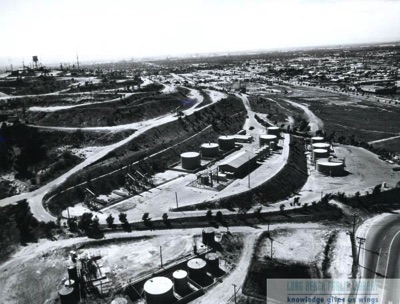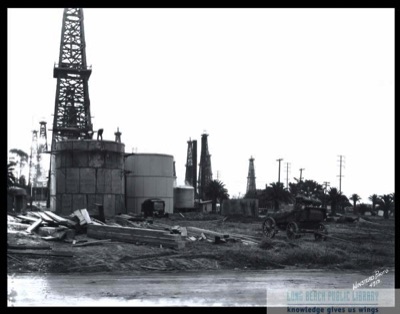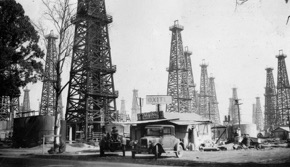The Story of Oil in California -
Signal Hill
Signal Hill rises up 110 meters (365 feet) behind Long Beach, 32 km (20 miles) south of Los Angeles. Its name is derived from a local Native American practice of signaling to each other from the imposing hill. Because of its size, signals could be sent by way of smoke or fire either to other hills in the area, or to boats out at sea. Oil men first started exploring the area in 1916 after the successes of other ventures in southern California. In 1921, Dr. W. Van Holst Pellekaan, Chief geologist for Shell, tried to stop the drilling at Signal Hill, unconvinced of its potential. He was too late, however, and the drilling proceeded.
The Shell Game
Shell's reluctance to drill Signal Hill was understandable. The company had spent three million dollars at Ventura in the previous 5years, and had no oil to show for it. And only 4 years before, Union Oil had drilled an unsuccessful well (also known as a "duster") on Signal Hill. But it was ultimately the tenacity of Frank Hayes and Alvin Theodore Schwennesen, geologists with Shell, that moved the project forward.
Work began on the Alamitos # 1 well on March 23rd. By May 2, the hole reached 843 meters (2,765 feet) and gave a showing of oil. Soon thereafter, 21 meters (70 feet) of standing oil was found in the bottom of the hole. But still, no oil flowed, and the crew, lead by driller O.P. "Happy" Yowells, began to wonder what exactly was happening. Then on June 23rd at 9:30 PM, the Alamitos #1 erupted with so great a gas pressure that oil gushed 35 meters (114 feet) into the air. Unfortunately, the bottom of the hole soon caved in. Much cleaning of the hole was required, and on June 25, 1921, the well was producing more than 1,000 barrels of oil per day. The well would eventually produce 700,000 barrels of oil.
The rush is on....
The discovery created a stampede. While the well was being drilled, the area was in the process of being subdivided into residential lots. Many of the lots, though already sold to prospective homeowners, were not yet built upon, and potential homeowners quickly changed their minds and entered the business of looking for oil, hoping to get rich quick. The parcels of land were so small and the forest of tall wooden derricks so thick that the legs of many of them actually intertwined. Oil promoters were selling shares of wells that had not yet been drilled. Signal Hill was to prove so prolific that, almost unbelievably, many of those buyers actually made money on their investments. The next-of-kin of persons buried in the Sunnyside Cemetery on Willow Street would eventually receive royalty checks for oil drawn out from beneath family grave plots.
By April 1922, only 10 months after completion of the discovery well, Signal Hill was covered with 108 wells, producing 14,000 barrels daily. By the fall of 1923, 259,000 barrels of crude was being produced every day from nearly 300 wells.
Signal Hill was the biggest field the already productive Southern California region had ever seen. In 1923, Signal Hill produced 244,000 barrels, alongside Huntington Beach (discovered in 1920) at 113,000 and Santa Fe (1921) at 32,000. This made California the nation's number-one producing state, and in 1923, California was the source of one-quarter of the world's entire output of oil! Even so, fears of shortage were still very much in the air. "The supply of crude petroleum in this country is being rapidly depleted", the Federal Trade Commission warned in 1923. But in that same year, American crude oil production exceeded domestic demand for the first time in a decade.
Remote location turns into tanker technology
Because of California's remote location relative to the industrial centers of the east, California oil companies were at the forefront of tanker technologies. As a consequence, much of the state's market was overseas. In 1894, the Pacific Coast Oil Company and the Union Oil Company partnered to build the first true oil tanker on the Pacific Ocean. Named the George Loomis, its maiden voyage departed Ventura, California in January, 1896, and a new era was born. The development of California oil also presented challenges to the geologist that had been seen in no other oil field. As a result, the complexities of the geology of Southern California lead to a significantly increased knowledge of petroleum geology and exploration.
By the end of 1938, the Long Beach Field had produced 614.5 million barrels of crude, 750 million barrels by 1950, and over 900 million barrels by 1980. This made Signal Hill one of the most productive fields per acre the world has ever known.
Source: The Paleontological Research Institution 1259 Trumansburg Road • Ithaca, NY 14850
References Franks, Kenny A. and Lambert, Paul F. (1985). "Early California Oil: A Photographic History, 1865-1940." Texas A&M University Press, College Station, Texas. 243 pp.
Yergin, Daniel (1991). "The Prize." Simon & Schuster, New York. 885 pp.
Rintoul, William (1976). "Spudding In." California Historical Society, San Francisco. 240 pp.
Lockwood, Charles (1980) "In the Los Angeles Oil Boom, Derricks Sprouted Like Trees." Smithsonian October, 1980. pp 187-206.
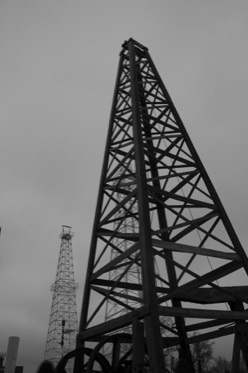
Within a year, Signal Hill – before and after a residential area – will have 108 wells, producing 14,000 barrels of oil a day.
The Alamitos No. 1 well erupted “black gold” on June 23, 1921, announcing discovery of California’s prolific Long Beach oil field.
The natural gas pressure is so great the gusher climbed 114 feet into the air. The well produced almost 600 barrels a day when completed on June 25. It will eventually produce 700,000 barrels.
The giant oilfield Alamitos No. 1 still produces 1.5 million barrels of oil a year. Signal Hill incorporated three years after the Alamitos discovery well.
Signal Hill remains the only city in America completely surrounded by another city – Long Beach. More than one billion barrels of oil have been pumped from the Long Beach oilfield since the original 1921 strike.
“Signal Hill is the scene of feverish activity, of an endless caravan of automobiles coming and going, of hustle and bustle, of a glow of optimism,” reported California Oil World.
“Derricks are being erected as fast as timber reaches the ground,” the magazine adds. “New companies are coming in overnight. Every available piece of acreage on and about Signal Hill is being signed up.”There are so many derricks, people are calling it Porcupine Hill.
“Derricks are so close that on Willow Street, Sunnyside Cemetery graves generated royalty checks to next-of-kin when oil was drawn from beneath family plots,” notes one historian.
Dave Summers notes in his article, ““The Oil Beneath California,” that when oilfields around Los Angeles began to develop, “Californian production became a significant player on the national stage.” The OilPrice.com article continues:
By 1923 it was producing some 259,000 barrels per day from some 300 wells, in comparison with Huntington Beach, which was then at 113,000 barrels per day and Santa Fe Springs at 32,000 barrels per day… And, in a foreboding of the future problems of over production, this was the first year in a decade that supply exceeded demand.
Shell Geologists seek Signal Hill Oil
Signal Hill oil potential had drawn wildcatters south of Los Angeles since 1917, but with no success. Two Royal Dutch Shell Oil Company geologists and a driller persevered.
“This was a great exploit and economic risk for the time. Shell Oil Company had just lost $3 million at a failed drilling site in Ventura, five years before,” explains a Long Beach newspaper.
A 1954 photograph of the Alamitos No. 1 well — and the monument dedicated on May 3, 1952, “as a tribute to the petroleum pioneers for their success here…”
Although another “dry hole” would be expensive, Shell geologists Frank Hayes and Alvin Theodore Schwennesen spudded their well in March 1921.
Driller Frank Hays believed oil lay deeper than earlier “dusters” had attempted to reach. By summer his steam-powered cable tool rig has him close.
On June 23, 1921, at a depth of 3,114 feet, Hay’s wildcat well for Shell Oil erupted “black gold” – revealing a petroleum reserve that extended to nearby Long Beach and into the history books.
According to the Paleontological Research Institution, Signal Hill became the biggest oil field the already productive Southern California region had ever seen. This made California, “the nation’s number-one producing state, and in 1923, California was the source of one-quarter of the world’s entire output of oil!”
Decades before Signal Hill, another giant southern California oilfield had been discovered in 1892. A struggling prospector drilled into tar seeps he found near present-day Dodger Stadium.

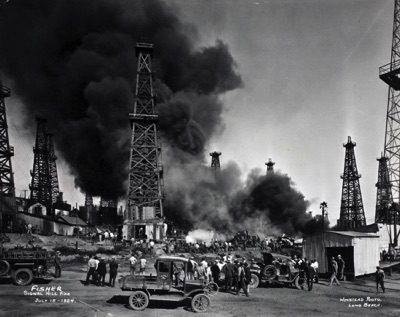
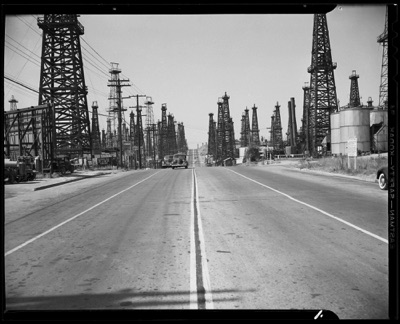
Atlantic Avenue and Patterson Street, Long Beach, are lined with oil derricks in 1940.
(Dick Whittington Studio/Corbis via Getty Images)
Oil fire on Signal Hill, July 15, 1924.
(Long Beach Firemen’s Historical Museum)
